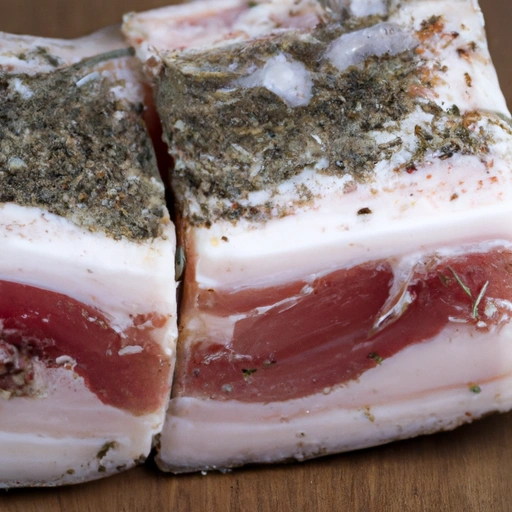Lardo
Description

Lardo is an indulgent food ingredient known for its rich flavor and silky texture. Made from the fatback of pigs, lardo undergoes a meticulous curing process that involves seasoning with herbs and spices, then aging in a controlled environment, often in marble containers. The result is a melt-in-your-mouth delicacy that can be used in a myriad of culinary applications. Lardo's versatility makes it a beloved ingredient among chefs and food enthusiasts across the globe, and it is commonly used in both American and European cuisines, measured in ounces (oz), pounds (lb), grams (g), and kilograms (kg).
Common uses
Lardo is commonly used as a spread on warm bread, as a flavor enhancer in dishes, or as a key ingredient in charcuterie boards. It can also be found draped over meats and vegetables before roasting to impart moisture and a subtle, aromatic flavor.
Nutritional value
Calories
Typically, lardo contains about 900 calories per 100 grams (approx. 3.5 oz).
Protein
Lardo offers a modest amount of protein, with roughly 2.4 grams per 100 grams (approx. 3.5 oz).
Fat
As a pure fat product, lardo is rich in fats, containing about 100 grams per 100 grams serving size.
Carbohydrates
Lardo contains negligible carbohydrates, with less than 1 gram per 100 grams (approx. 3.5 oz).
Vitamins
Lardo provides some fat-soluble vitamins, particularly Vitamin E.
Minerals
It also contains small amounts of minerals such as zinc and iron, which are essential for various bodily functions.
Health benefits
While lardo is high in fat, it does contain beneficial monounsaturated fats and has small amounts of vitamins and minerals. Its consumption should be moderate within a balanced diet.
Potential risks
Due to its high saturated fat content, overconsumption of lardo may pose risks to heart health, and those with dietary constraints should consume it in moderation.
Common recipes
Lardo can be used in recipes ranging from simple lardo on toast to complex dishes like Lardo wrapped scallops or incorporated into pastries for added richness.
Cooking methods
Lardo can be eaten raw, gently warmed, or used to cook and baste other ingredients.
Pairing with other ingredients
This fatty delicacy pairs well with robust flavors such as rosemary, garlic, and black pepper, as well as with acidic components like pickles or sharp cheeses which cut through its richness.
Summary
Lardo is a luxurious and historically rich food ingredient that offers a unique combination of creamy texture and depth of flavor. It is a versatile component in various culinary traditions and can elevate simple dishes to gourmet status. Whether thinly sliced and enjoyed on its own or used as a cooking fat, lardo's culinary potential is immense, and it continues to be cherished by food lovers around the world.